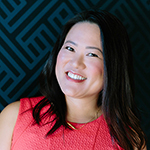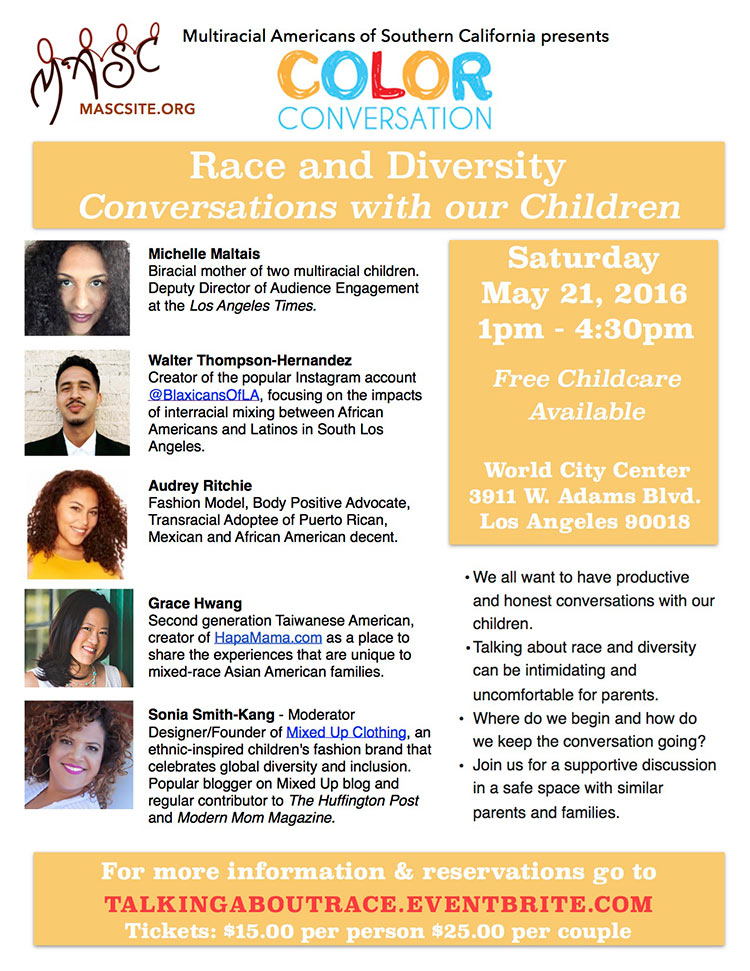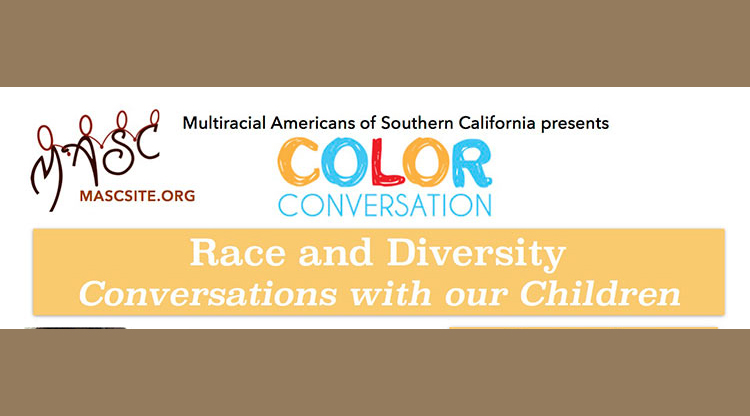Are you the parent of mixed-race kids in Southern California? Multiracial Americans of Southern California will be holding an event you won’t want to miss on Saturday, May 21. It’s a discussion about how to talk to kids about race and diversity, featuring a panel of diverse writers and speakers — including myself.
Scroll down to learn more about the panelists and also for a Q & A with Mixed-Up Clothing creator Sonia Smith-Kang, who is also the vice president of MASC.
Q & A with Sonia Smith-Kang of Multiracials of Southern California
HM: You’re the Vice President of MASC, Multiracial Americans of Southern California. Can you start us off with some background about the group? Who is MASC for and how did it come about?
SSK: Sure, I hope you don’t mind me answering by starting off with a bit about me. I identify as mixed: Mexican and Black. My parents were in the service so I was born in Puerto Rico. We were then transferred to Oahu, Hawaii. Like a lot of military families, I also identify as a Third Culture Kid, which simply means I was raised in a culture outside of my parents’ culture.
Today, I am married to my Korean husband and together we raise our 4 kids as mini global citizens.
Growing up I tried to find ways to “fit in” and found it difficult. There weren’t very many people, let alone, any organizations or groups I fit into or reflected me as an individual or as a multiracial family. Until I found MASC!
MASC stands for Multiracial Americans of Southern California. MASC is a 501c3 non-profit organization dedicated to educating, supporting, and advocating for the multicultural community, multiracial, biracial, and trans-racially adopted people and families. Last year we celebrated our or 25th year and I have proudly served on the board and now as VP for close to 5 years.
HM: Tell us a little about how the idea for the May 21 seminar on Race and Diversity Conversations With Our Children came about… it’s part of MASC’s Color Conversation series for parents, right?
SSK: The Color Conversation is our parenting seminar series that brings parents together to dialogue about the issues affecting them and take away practical parenting techniques. Part seminar, part workshop, part support group, Color Conversation grew out of our PLAYgroup when parents expressed an interest in more than socializing.
The May 21 seminar is about talking about race and diversity. Pretty important stuff and very timely with everything going on in the world right now. As a parent of kids that range from 8 to 24 I have had my share of “talks”. I had the “birds and the bees,” “say no to drugs and alcohol,” and even heavy talks like “how to be brown in today’s society.” I also have the “race and diversity” talk with my children early on and continue it throughout their different stages of life. I base my talk with the kids on my work, my research and ,frankly, I googled some stuff. I knew if I was having questions, others were probably having the same questions so let’s come together in a safe place and talk about it through the Color Conversation parenting series. I may not have a parenting manual, but what I do have is a supportive organization and resources to pull together expert panelists, like yourself and the others that are joining us: Michelle Gurdal, Walter Thompson-Hernandez and Audrey Ritchie.
HM: What are we going to be talking about during the panel?
SSK: Together we will be sharing our knowledge, the work we do and our experience in relation to race and diversity with the attendees.
Like at other Color Conversations, parents will hear from guest speakers, join in facilitated dialogue, socialize comfortably, and enjoy free childcare to make attendance as easy as possible.
HM: Sometimes I hear parents say they don’t know how to talk about race or that they think living in California/New York/insert name of city, race isn’t an issue. What are the pitfalls of that line of thinking?
SSK: Talking about race is difficult. I think I had an easier time explaining the birds and the bees than I did the race talk but it’s an important topic that needs addressing. It’s a myth to believe that by not talking about race, your children will not see racial differences. It simply is not true. Research shows us that the “color-blind” approach does not work. Young children that do not learn about race may interpret the silence as something that is taboo and therefore feared or wrong. That’s not what we want. As a mixed woman, I tell folks I don’t mind you seeing me for who I am. I want you to know about me. It’s the assumptions one may makes based on who I am, where there may be issues.
HM: Anything else people should know?
SSK: Sure, the multi- community is one of the fastest growing populations and we are more vocal than ever. There are many wonderful individuals and organizations working tirelessly on getting our reality reflected in the mainstream. OMG, yes we can have Asians as the lead actors in a movie. Yes we can have a black and mixed race family represented on network TV. Yes we can have a plus size Latina model on the cover of a sports magazine. And guess what? They’re successful. Bottom line: we are here and we ain’t going anywhere!
Want to learn more about how to talk to kids about race and diversity?
Tickets for the Color Conversation are available at talkingaboutrace.eventbrite.com



Thank you for this, Grace. So glad you will be joining us on the panel this weekend. Until then, Sonia